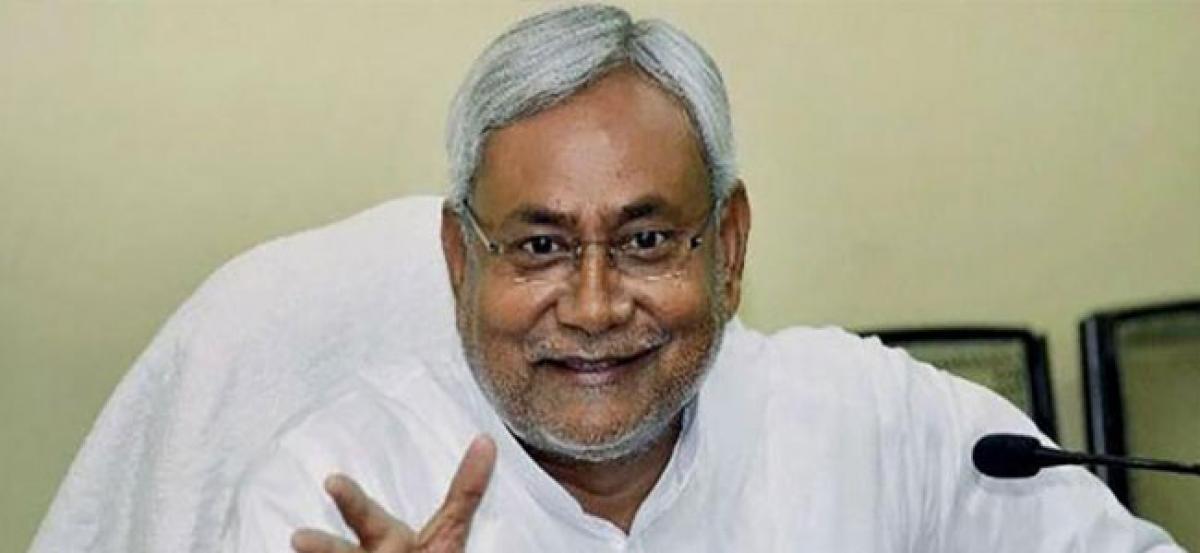Live
- 15 Telangana boys bag perfect 100 percentile in JEE Mains Session–II
- Bheemili developed with Rs 3,800 cr in TDP rule: Ganta
- Special Police Observer reviews poll arrangements
- TS LAWCET, PGLCET registration date extended
- Andhra Paper lockout creates stir
- Cyberabad cops ban drone flights for V-P visit today
- Petrol and diesel prices today stable in Hyderabad, Delhi, Chennai and Mumbai on 26 April
- Gold rates in Delhi slashes, check the rates on 26 April 2024
- OU comes alive with vibrant celebration of Taksh festival
- Gold rates in Vijayawada slashes, check the rates on 26 April 2024
Just In
Improvising tactics by forming alliances, for the 2019 electoral contest


The recent withdrawal of support by the BJP from the PDP has led the government in Jammu and Kashmir to be highlighted again on how the issue of alliances of political parties might shape the 2019 electoral contest. Nitish Kumar the CM of Bihar made a move to raise the demand for a special status for his state at the recent Niti Aayog meeting which created intense speculation about various possib
The recent withdrawal of support by the BJP from the PDP has led the government in Jammu and Kashmir to be highlighted again on how the issue of alliances of political parties might shape the 2019 electoral contest. Nitish Kumar the CM of Bihar made a move to raise the demand for a special status for his state at the recent Niti Aayog meeting which created intense speculation about various possibilities.
The BJP had already lost one ally, which is the Telugu Desam party, while the Shiv Sena and Akali Dal don’t seem to be very happy with it. The saffron party has already broken its alliance with the PDP. The Congress is also finding the task of building alliances to be hard. The regional parties understand the urgency and need to come together on a common, united platform, but many regional leaders who are popular in their own states are not willing to accept the leadership of Rahul Gandhi. The Congress might have to do a tightrope walk to make sure it has allies. It will find seat-sharing deals to be a tricky affair in big states where it’s a marginal player.
The Congress’ prospects in 2019 depend largely on how it prospers in states where it is in a direct competition with the BJP and in other states where it is pitted against both the BJP and regional parties. There will be a bipolar contest between the BJP and the Congress. These states have 104 Lok Sabha seats and in 2014 the BJP won 99 seats and the Congress was routed. There are rumours about the Congress exploring alliances with the BSP and smaller regional parties to improvise on its prospects.
The party needs to prevent the fragmentation of the opposition vote through tie ups with regional parties if it hopes to improve on its 2014 performance. In Haryana, for instance, the Congress was pushed to third place in 2014. It has already made a move for a comeback through a merger of Kuldeep Bishnoi of Haryana Janhit Congress. The HJC had contested the 2014 polls alongside the BJP and could help the Congress in a few seats.
The BJP has too many problems of its own. In Bihar and Maharashtra, which gave the NDA 73 Lok Sabha seats in 2014, it needs to pacify its allies and prevent them from exiting. The main reason for discontent seems to be the role reversal in the relationship between the regional parties (JD-U and Shiv Sena) and the BJP after 2014. Unlike earlier, the BJP sees itself as the senior partner in the alliance as it has larger support comparatively based on both states. In the 2014 Assembly elections, the BJP and the Shiv Sena contested separately and the BJP was clearly ahead of the Sena. But despite the aggressive public posturing, both parties are aware that contesting alone will be fatal if the Congress and NCP contest together.
Voters appear to be more prepared to accept alliances and coalitions than they were in the 1990s, but only if they are based on some common principles. But the way things are moving, it seems alliances in 2019 would be guided solely by electoral considerations, not on shared ideology.

© 2024 Hyderabad Media House Limited/The Hans India. All rights reserved. Powered by hocalwire.com






